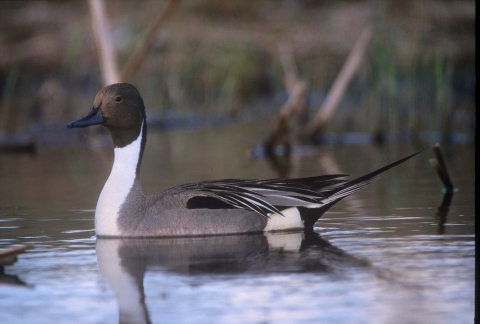What We Do
To help plants and wildlife, Refuge staff use a variety of habitat management techniques to maintain, enhance, or recover plant and wildlife values. Refuge staff considers a number of management tools and employs them in varying degrees according to the situation.
Refuge management goals include:
- Conserve, protect and enhance fish, wildlife, and their habitat
- Sustain and restore native prairie
- Enhance waterfowl production
- Promote the diversity of native species
In wetlands, the species of plants and the density of vegetation change as the wetland goes through wet and dry periods. During dry periods, wetland plants die, keeping the vegetation from becoming too thick for waterfowl. Refuge staff sometimes mow or disc wetlands to reduce vegetation and create open areas for the benefit of wildlife.
Management and Conservation
Haying and Mowing
Haying and mowing at the right time of year benefits grasslands in the following ways:
- Increases plant diversity and yield
- Limits the spread of noxious weeds
- Reduces the use of herbicides
- Increases plant density for the benefit of wildlife
Grazing
Upper Souris National Wildlife Refuge uses cattle as a tool to manage grasslands for the benefit of wildlife habitat. While Refuge staff use grazing to gain desirable wildlife habitat conditions, grazing cooperators gain quality forage for their cattle. In general, the Refuge subscribes to short duration, high intensity grazing to benefit grasslands. Grazing benefits grasslands in the following ways:
- Stimulates new plant growth
- Increases native plant diversity and reduces invasive weeds
- Loosens the soil and prepares a seedbed for native plants
- Reduces thatch and recycles nutrients into the soil
Local Cooperators are given permits to graze specific units. If you would like more information about our grazing program or are interested in becoming a cooperator, please contact us.
View the 2025 Refuge grazing Cooperative Agriculture Agreement application and refuge grazing unit maps.
View the 2025 Waterfowl Protection Area (WPA) grazing Cooperative Agriculture Agreement application and WPA unit maps.
Learn more about local and national haying and grazing opportunities.
Prescribed Burning
Prescribed burning is used to manage grasslands the way natural fires once did. Historically, natural fires caused by lightning burned the grasslands and marshes, recycling nutrients, cleaning out old growth and promoting new vegetation. Refuge staff use prescribed burns to manage grasslands the way natural fires once did. Benefits of burning include:
- Improves native habitats and controls noxious weeds
- Reduces thatch and promotes seed germination
- Increases nesting and escape cover for birds
- Stimulates the growth of sprouts which are food for deer and other wildlife
Invasive Species
Invasive weeds have few natural enemies, so insects that feed on these plants must be introduced onto the Refuge from the weed's native land. Biological controls such as beetles, reduce the amount of pesticides used on the Refuge and attack only the target weed species.
Water Management
Lake Darling, a 9,600 acre lake named in honor of Ding Darling, a political cartoonist and first director of the U.S. Bureau of Biological Survey (predecessor to the U.S. Fish and Wildlife Service) is the largest of several water impoundments on Upper Souris National Wildlife Refuge. The lake's primary purpose is to furnish a regulated water supply to smaller marshes downstream and especially to the larger marshes on the J. Clark Salyer National Wildlife Refuge, 110 miles downstream. The lake is designed to hold a two-year supply of water to safeguard marshes downstream against the threat of drought. The dam also makes it possible to reduce the flooding and to regulate releases during periods of low flow. Both operations benefit people in the valley below the dam.
In 1998, the dam also became an integral part of the Souris River Flood Control Project that assists in providing 100-year flood protection for the city of Minot.
Our Services
At this field station we offer the following public services:
- A small contact station with local hunting and wildlife viewing information.
- Educational brochures, including a map of Waterfowl Production Areas.
- Environmental education programs for local schools and groups (contact Refuge manager).
- Administration of cooperative agriculture programs.
- Issuance of Special Use Permits.
- Project reviews related to energy development when U.S. Fish and Wildlife Service interests are involved.
Laws and Regulations
U.S. Fish and Wildlife Service follows Federal laws, policies, and treaties passed throughout history. Click on the "Laws and Regulations" tab under "What We Do" to learn about important acts that pertain to Upper Souris National Wildlife Refuge.
